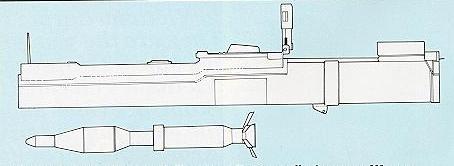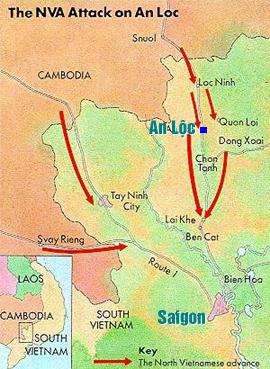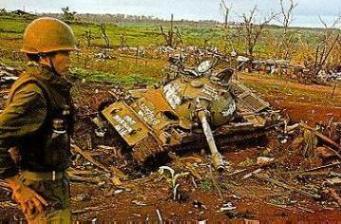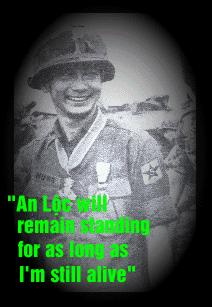Three days of hard fighting had gone by and the defenders had yet to have any resupplies nor reinforcement. Running low on ammunition, ARVN soldiers in Loc Ninh began to feel more pressurẹ On April 7, after withstanding so many shocking enemy artillery pounding and infrantry attacks, the defenders received orders to withdraw from Loc Ninh and to move back to An Loc. On their path of retreat, ARVN soldiers ran into a Communist ambush on Highway 13 and took heavy losses. None of the ARVN tanks from Loc Ninh ever made it back to An Loc. However, the ARVN 1st Battalion of the 48th Regiment was the only unit fortunate enough to suffer light casualties. But the threeđay battle at Loc Ninh had cost both sides dearly: 2,150 dead. South Vietnamese casualties: 600 lives. After capturing Loc Ninh on April 7, the 5th NVA Division pushed south toward An Loc. On that day, the forward elements of this division took Quan Loi airfield, three kilometers to the east of An Loc. Since the 7th NVA Division had already cut Highway 13 south of An Loc, the capture of Quan Loi airfield had strategically isolated the town. In ađition, the high ground at Quan Loi offered the Communists excellent observation and fields of fire into An Loc. An Loc at the time was held by only one ARVN army regiment and two ranger battalions, both of which had been sent to An Loc on April 5. An Loc, the site of the proposed capital of the Provisional Revolutionary Government (PRG), now besieged by two NVA divisions, looked ripe for the picking. And it would have been, too, except for one major obstacle: the South Vietnamese soldiers, paramilitary, and civilians of An Loc had determined to defend the town at all cost. During an emergency meeting at the Independence Palace in Saigon on April 6, president Thieu decided to send the 21st ARVN Infantry Division from the Mekong Delta and the remaining airborne brigade (the last unit of his general reserve) to buttress the defense of An Loc. With the 21st ARVN Division now on the way, the III Corps commander was able to send two more battalions from the 5th ARVN Division into An Loc, bringing the strength of its defenders up to nearly 3,000 men. Daily, the pressure increased on An Loc. Supplies depended entirely on helicopters and air drops from C-123 aircraft; the wounded could only be evacuated by helicopters. By nightfall of 12 April, all signs pointed to an imminent and major NVA attack to take An Loc.
On April 14, a meeting was held in Lai Khe between General Nguyen Van Minh and Colonel Le Quang Luong, 1st Airborne Brigade commander. The general expressed his concern over the situation at An Loc and was wanting to know if there was any way to link up with the besieged garrison. With all northern, western, and southern roads leading into An Loc blocked by the Communists, Colonel Luong suggested that reinforcement be air lifted to the few hills southeast of An Loc. And from there, reinforcement troops could have a closer leap into the citỵ General Minh approved the plan, and the ARVN's 1st Airborne Brigade was chosen to take on this dangerous task.  Sitting high above from his observation helicopter, Colonel Luong ordered his paratroopers to land at Srok Ton Cui, a small hamlet 4 kilometers to the east of An Loc. The 61st Company of the 6th Battalion was the first to arrive, followed by the 62nd Companỵ The paratroopers quickly overwhelmed a small group of Viet Cong on Doi Gio, or "Windy Hill." On April 15, the entire paratrooper brigade and its commanding staff arrived, bringing the strength of the paratroopers up to 3 battalions. Under the command of Colonel Le Quang Luong, the 5th and 8th splitted into two prongs heading for An Loc, while the 6th stayed behind to guard Windy Hill. On April 9, encouraging news arrived from Military Region I: using M72 anti-tank guns, South Vietnamese Marines had successfully repulsed the Communist armour attacks. The good news quickly spreaded around the nation as military information were being passed on to ARVN commanders stationed at different battlefields. In An Loc, General Le Van Hung wasted no time as he was making sure all soldiers and civilian defenders received adequate training with the M72 LAW's. This preparation had later proven to be a devastating defeat for the Communist tankers. On April 15, from Lai Khe General Nguyen Van Minh formed a new 20,000 man force to help reopen Highway 13. The 6th Airborne Battalion was (later) also part of this new An Loc relieving forcẹ (On April 20, the 6th Battalion suffered heavy casualties in the big battle at Windy Hill. Later, after being reinforced with fresh troops, this paratrooper battalion managed to launch several successful counter attacks to link up with ARVN troops in An Loc).
Then on April 16, the elite South Vietnamese 81st Airborne Ranger Group was airlifted from Military Region I into An Loc. These ARVN special force personnel were used for conducting covert military operations and battlefield reconnaissancẹ These elite soldiers were assigned the task of flushing out strong pockets of Communist resistance in the nothern sector of An Loc. The enemy were heavily armed and well digged in. Dislodging them from the city would require the use of awesome preparatory firepower coupled with an assault of a large number of troops. At the moment, the An Loc defenders has none of the above factors available at their disposal. At least not until when the South Vietnamese elite airborne rangers arrived. When night falls, the airborne rangers began to move out to clear enemýs pockets of resistancẹ Crawling in darkness, these soldiers inched their way as close to enemýs positions as they could before making a surprise attack. With grenades being lofted at a relatively short distance, this battle had become a dangerously fierceful business. Throughout the night on April 17, the sound of grenade explosion could be heard continuously in the northern sector of the citỵ By early dawn, after a long hard fought battle, all enemy strong points in An Loc had been wiped out by the ARVN special forcẹ Communist troops were heavily armed and well digged in. But they were still no match for the elite South Vietnamese airborne rangers. In the mean time, ARVN forces did have some major problems back at basẹ Their main ammunition dump in Lai Khe was destroyed by Communist artillery while Highway 13 remained under enemy blockadẹ But inspite all these, the South Vietnamese weren't about to give up. They were confident that the Communist offensive will be stomped, and the enemy will be thrown back in defeat. On April 17, at a press conference in Lai Khe, General Nguyen Van Minh announced that "The first set of obstacles has been cleared. An Loc will stand, and our troops are strong enough to repulse any ađitional rounds of enemýs attacks. Our objective is to defeat Communist aggression while minimizing the soldier and civilian casualties." On the following day, April 18, the Communists renewed their offensive by sending more tanks rumbling into An Loc. This time, the battlefield was much more devastating than the fight at Dien Bien Phu 18 years agọ But according to one international news correspondent, "the wind of favorability had shifted against Giap." And truely it had. ARVN soldiers in An Loc were strongly united and ready to fight. General Le Van Hung, ARVN 5th Division's top brass had declared: "An Loc will remain standing for as long as Ím still alivẹ" Dressed in short and t-shirt, always with an M-16 rifle in his hands and grenades clipping around his body, the general was working hard on a 24 hour basis. The city of An Loc was blessed to have a commander like general Hung. And under his leadership, An Loc still remained standing even after the city had been battered with so many thousands of Communist artillery shells and countless waves of infantry attacks. On April 21, the battlefield fiercely flared up again when An Loc was shaken by 2,000 Communist artillery rounds. Enemy infantry and amour units came charging at four different locations: - 2 km southeast of An Loc The Communists struck the defenders on four different fronts. Each attacking prong was spearheaded by 5 to 6 tanks with infantry escort. But for some reason these attacks weren't being launched at the same timẹ The first one got off at 4am early in the morning while the last one didn't get start until one óclock in the afternoon. The element of coordination was missing from these Communist attacks. And that had allowed the defenders to concentrate their firepower on to one battle front at a timẹ Again, with the M72 LAW's, the ARVN soldiers managed to knock out many enemy tanks to repell the Communist amour push. The US Air Force (USAF) and South Vietnamese Air Force (SVNAF) also contributed a great deal in stopping the Communist offensivẹ More than 17 B-52 sorties had been flown in support of the defenders, including 3 B-52 passes wrecking havoc on enemy positions on Windy Hill. The Communists renewed their offensive on April 22 with one infantry regiment charging the southern sector of An Loc while another unit was used to ambush the ARVN 15th Regiment on Highway 13. An Loc's southern sector was defended by Colonel Van Ba Ninh's 8th Airborne Battalion. Using the XM202, a modified version of the M72 LAW, the paratroopers destroyed two enemy T-54's and two BTR's (the Soviet supplied T-54 main batle tank is the equivalent of the American M-48, and the BTR is one type of amored personnel carrier used by the Communist in South Vietnam). With their amored vehicles blown into pieces by the anti-tank rounds, Communist troops panicked and began to flee from the battlefield. Suspecting more enemy tanks in the area, Lieutenant Colonel Van Ba Ninh quickly radioed a USAF C-130 "Spectrum" gunship asking for help. Armed with a single 105mm cannon and three 20mm Ratling guns, the C-130 is capable of spitting out more than 6,000 rounds of ammunition per minutẹ After getting radio calls from Colonel Van Ba Ninh, the C-130 quickly got to the battlezonẹ Banking in a circular path, the gunship opened up with its guns as her crew caught five Communist tanks wide in the open. Spectacular traces of fires came streaking down to earth bursting enemy tanks into flames. The battle of An Loc was not being fought on the ground alonẹ Every single day the USAF and the SVNAF would lose some number of helicopters to enemýs anti-aircraft fires. In ađition to the ZSU-23's and ZSU-57's (Soviet made 23mm and 57mm anti-aircraft artillery), the Communist also had SA-7's (Soviet made shoulder-launched heat-seeking anti-aircraft missile) at their disposal. The landing of choppers at An Loc was thus impossiblẹ And many wounded defenders later died because they just could not be evacuated from the citỵ After four failure attempts to take An Loc, the Communists had lost their momentum. Although enemy artillery shells continued to pound An Loc every daỵ But infantry and amour attacks had slacked off. In the mean time, blood continued to spill on Highway 13 between Chon Thanh and An Loc. ARVN relief forces ran into stiff resistance put up by the Communists. The battle for Highway 13 was fought so fiercely that many Communist officers decided to chain their troops to fox holes, mortars, or heavy machine gun units to force these men to fight to their deaths. Retreating or surrendering was not an option. Unfortunately, this horrible war crime continued to be committed by the Communists throughout the Vietnam War. Moving down Highway 13, the paratroopers also had their shares of hard work. When trying to reopen this road, Airborne troops had to be mobilized at battalion strength before any ground advance could be madẹ Communist troops stationed along Highway 13 were heavily armed and well protected in fortified bunkers. These bunkers were burried as deep as 6 meters into the ground. Bombs dropped from the air were just simply not strong enough to penetrate these underground fortifications. The only way to flush the enemy out was to get close enough to the bunkers and toss grenades into the insidẹ This process was dangerous and time consuming. It took the South Vietnamese weeks of hard fighting to have Highway 13 reopened. On May 8, two army regiments of the ARVN 21st Division were air lifted to an area north of Tau O villagẹ These soldiers charged the village to link up with another ARVN unit attacking from the south. Here, it was at the "Battle of Tau O" that 6 Communist infantry battalions, with the support of an ađitional artillery battlion, suffered heavy destruction at the hands of ARVN soldiers. The capturing of Tau O village meant that the South Vietnamese could now use that as a launching pad to make their jump into An Loc. By May 10, the situation on three battle fronts: An Loc (Military Region III), Kontum (Military Region II), and Tri Thien (Military Region I) had been critical. From across the Pacific, President Richard Nixon announced the United States will use all necessary means to punish North Vietnam for its military aggression. In Saigon, President Thieu declared "the nation's security is now at risk". National military curfews would come into effect starting on the following daỵ Not since the Communist Tet Offensive in 1968 had there been a serious situation like this. But it was on this date, May 10, that the Communists had decided to "send a knock out blow to finish off An Loc and capture General Le Van Hung alivẹ" At exactly midnight on May 10, Communist artillery shells began to rain down on An Loc. The artillery pounding would continue for hours. A total of five thousands rounds were fired to prepare for the final assault. By no doubt, this was the deadliest artillery bombardment in the history of any Indochina conflict. At 4am in the morning of May 11, Communist tanks and infantry advanced from three direction: north, northeast, and northwest. Each Communist attacking "wing" was spearheaded by tanks and amored vehicles protected by one infantry regiment. The enemy had determined to throw everything they had into this battle hoping to crush the defenders and capture the citỵ To avoid the defenders' anti-tank missiles, Communist tank crews had their vehicles running at full speed. For that matter, the amored monsters had unintentionally left their infantry far behind. As the tanks broke through several ARVN's defensive lines, they found themselves wandering around the city without infantry support. South Vietnamese defenders wasted no timẹ With their M72's, XM202's, and some captured B40's, the defenders quickly put 8 enemy tanks out of action. But this was not enough to stop Communist human wave assault. In the northern sector, the defenders momentarily felt back. But in exchange for some lost ground, they inflicted heavy casualties on the enemỵ With intelligence reports indicating the exact time and date of this latest round of Communist offensive, Lieutenant General Nguyen Van Minh had requested for an ample amount of B-52 sorties to support An Loc. When Communist troops began their assault into the northern sector of An Loc, the B-52's weren't late for the bombing rendezvous as tons of bombs were raining down on enemy positions just right on outskirt of the citỵ One Communist regiment was entirely wiped out. Hundreds of dead enemy soldiers lied scattering all over the ground. And none of their bodies were found in one piecẹ On May 12, the Communists concentrated their effort by launching three more attacks into An Loc from three direction: south, west, and northeast. The defenders fought back with everything they had. And no unit was willing to give away any ground. One particular group of South Vietnamese defenders consisting mostly of Binh Long policemen were credited with the destruction of two enemy PT-76's (armored personnel carriers). Every day, An Loc continued to be resupplied by air. Packages of ammunition, food, and medicine were being parachuted the South Vietnamese Air Force at a high altitude from abovẹ Not all packages landed inside the compound, however. Some drifted away from the city and fell into areas controlled by the Communists. The South Vietnamese had been put to fight under pressure for 40 intensive days. Lacking of ammunition, food, water, and medical supplies, the defenders still managed to push back many rounds of enemy attacks. There was no question about the fighting capability of the South Vietnamese soldiers. If given an ample amount of ammunition, and if they were well led, the South Vietnamese soldiers could wreck havoc on their Communist counterpart in no timẹ With breaking morale, Communist troops were never able to regain their offensive momentum. What happened after May 13 was just another series of Communist defeats. During this week of May, relief forces from the ARVN 21st Division had captured strategic locations around An Loc This included Tau O, Tan Khai, Xa Cat, and Xa Trach. By noon on May 16, ARVN reinforcement troops were only 3 kilometers away from An Loc. May 19 marked another turning point for this battlẹ Six B-52 sorties were flown in to drop bombs on suspected Communist positions 16 kilometers southeast of An Loc. The bombers struck hard with deadly precision, killing as much as eighty percent of the Communist's Binh Long provincial commanding staff.
On May 23, the Communist mounted another offensive into An Loc. But this time, the enemy push was weak and insignificant. Four different enemy attacks were aimed at ARVN's positions in the southern and southwestern sectors of An Loc. After several hours of fighting, the attacks were driven off. Communist troops withdrew from the battlefield, leaving behind them 13 of their amored vehicles totally destructed. In all, the Communists suffered 30,000 casualties at the battle of An Loc. Although with a superior advantage over the defenders in terms of manpower and fire power, the enemy had underestimated the fighting spirit of the South Vietnamese soldiers. An Loc was defended by some of the best ARVN units. This included the 7th and 8th Infantry Regiment (of the 5th Army Division), the 1st Airborne Brigade, and the elite 81st Airborne Ranger Group. In ađition to that, the Communists had yet to master the art of urban tank warfarẹ Communist amored vehicles were often seen running around unprotected by infantrỵ This was proven to be a major defeat for the enemy from the beginning. In the end, more than 50 enemy amored vehicles of all types were destroyed in this battle alonẹ The key factor in helping An Loc to stand firm was the courageous effort put up by the South Vietnamese soldiers. Besieged for months with an inadequate amount of ammunition and medical supplies, the soldiers had to endure a great deal of hardship to bring forth victorỵ In their battle against the Communist, the defenders got a lot of helps from the big American B-52's and as well as from other US helicopters and attack aircraft. But An Loc could not be saved from the air alonẹ It would take a great deal of brave fighting with guts and glory to keep the city from falling into Communist occupation. And under the given unfavorable circumstances, the South Vietnamese had done that just outstandinglỵ Jennifer W. Nguyen
|



